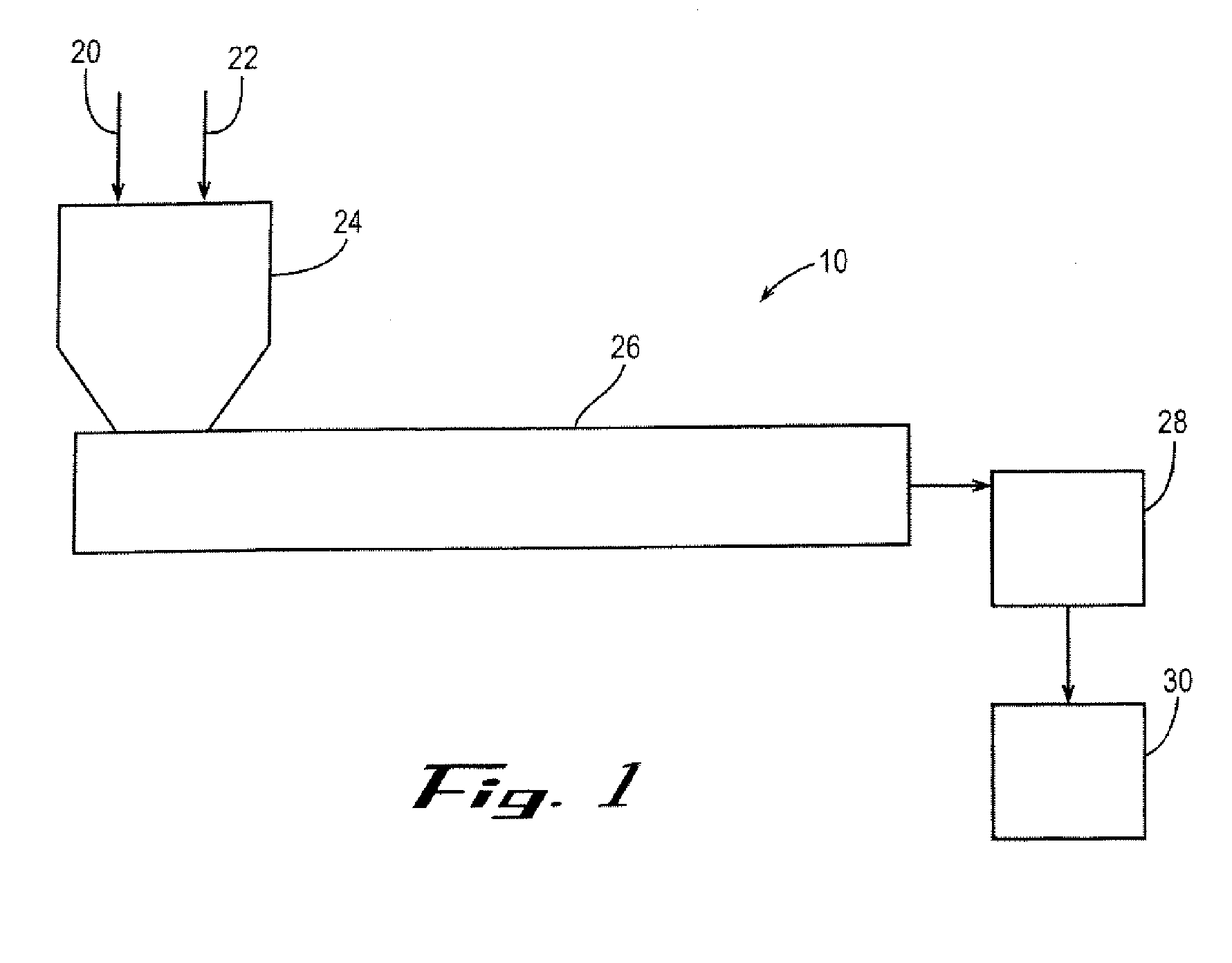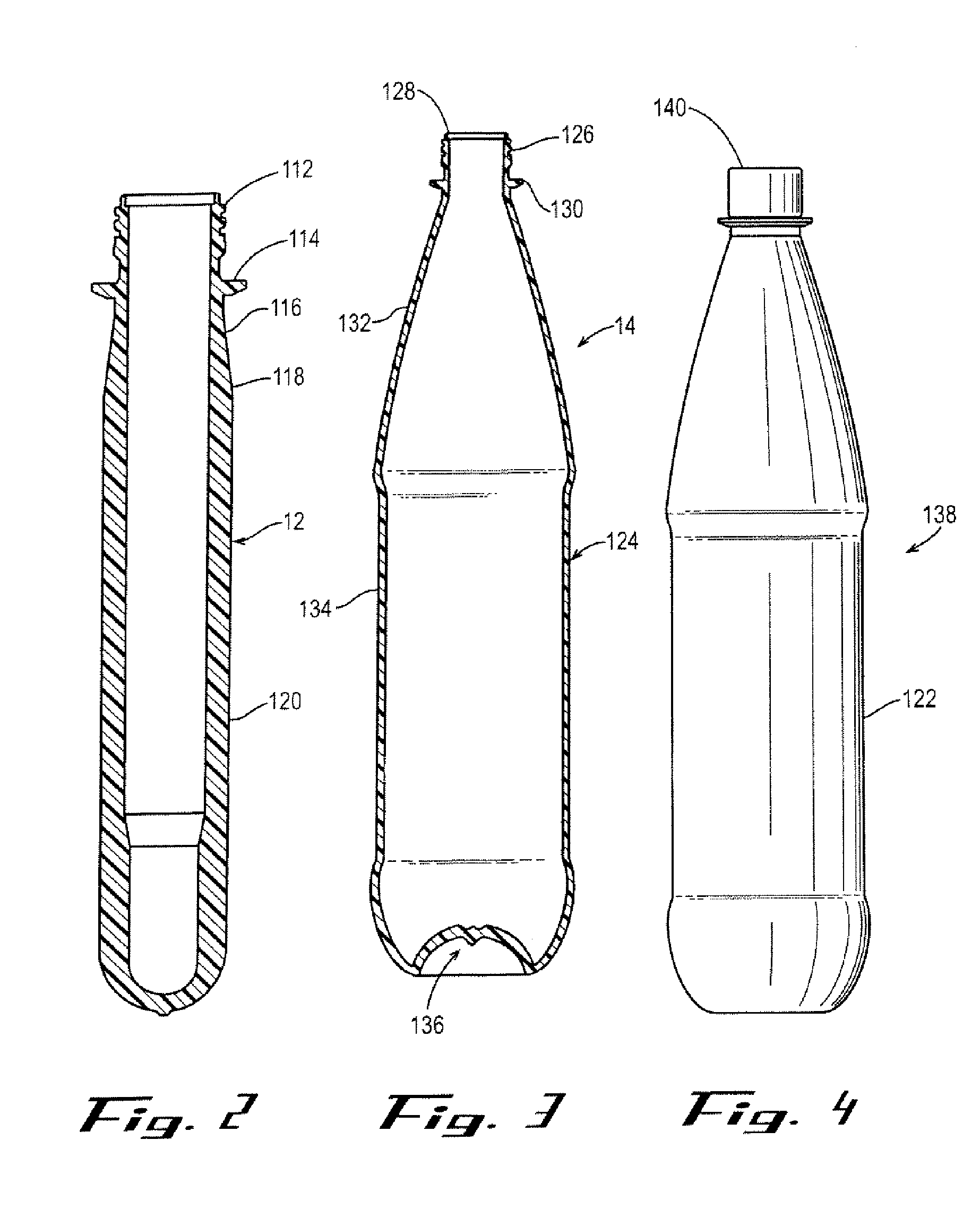Polyester Container with Enhanced Gas Barrier and Method
a technology of gas barrier and polymer, applied in the field of polymer containers, can solve the problems of insufficient gas barrier of pet to oxygen and carbon dioxide, limiting the application of pet for smaller sized packages, and limiting the use of smaller pet containers for packaging carbonated soft drinks, etc., and achieves enhanced gas barrier properties, enhanced additives, and enhanced gas barrier containers
- Summary
- Abstract
- Description
- Claims
- Application Information
AI Technical Summary
Benefits of technology
Problems solved by technology
Method used
Image
Examples
example 1
[0056] An experimental PET resin was made using a Ti catalyst. The resin contained no antimony, cobalt, zinc, or manganese. The PET copolymer was dried in a vacuum oven at 140° C. overnight to a moisture level below 50 ppm. The additives were dried in a vacuum oven at 100° C. for 2 hours to remove the surface moisture. The PET copolymer and loading levels of 3 wt % of DMT or DMI were mixed and then injection molded in a lab Arburg unit cavity injection molding machine to make 24.5-g 500-ml preforms. The preforms were then blow molded with a Sidel SBO 2 / 3 blow molding machine to make acceptable 500 ml bottles. The oxygen transmission rate of the bottles was measured using a Mocon 2 / 60 model instrument at 22.2° C. and 50% RH with the 99% N2 / 1% H2 purging rate of 10 ml / min. The results are shown in Table 1. Also shown in this table are the preform IV results, measured according to ASTM D 4603-96 at 30° C. with 0.5 weight percent concentration in a 60 / 40 (by weight fraction) phenol / 1,1,...
example 2
[0057] A commercially available PET copolymer bottle grade resin manufactured by Eastman Chemical, in Kingsport, Tenn., with less than 3 mole % of cyclohexanedimethanol modification to the diol, was used as control. The PET copolymer was dried in a vacuum oven at 140° C. overnight to a moisture level below 50 ppm. The additives were dried in a vacuum oven at 100° C. for 2 hours to remove the surface moisture. The PET copolymer and 5 wt % loading level of additive was mixed and then injection molded in a lab Arburg unit cavity injection molding machine to make 26.5-g preforms. The preforms were blow molded with a Sidel SBO 2 / 3 blow molding machine to make acceptable 20-oz bottles. The bottles' barrier properties were then determined using a FTIR instrument according to the method disclosed in U.S. Pat. No. 5,473,161. The shelf life, in weeks, is shown in Table 2. The higher the shelf life, the higher the barrier. A shelf life improvement of 20% or more is considered to be effective. ...
example 3
[0060] To show the effect of the catalyst choice on the IV of the polymer composition, several different polymer resins were subjected to metals analysis to insure that they were free of cobalt, antimony, zinc, manganese, magnesium, cesium, calcium, and cadmium residues. The catalyst and concentrations of metal residues are shown in Table 3.
TABLE 3Conc.in ppmWellmanZimmer8006CB12MitsuiToyoboToyobo1101E(ug / gram)Ti 818CC3M & GVordianC135SB-IPETGS-IPETInvistaBlankLi0.080.000.000.000.000.000.000.000.00Mg0.140.610.790.310.830.340.150.100.32Al0.201.001.500.2813.000.4117.000.230.47Ca0.000.001.202.3013.000.000.870.001.80Ti28.0021.001.800.3063.000.260.460.130.28Mn0.290.520.840.130.500.050.050.180.06Co25.000.520.261.100.350.060.0635.000.34Zn0.110.290.931.500.970.130.380.150.94Sb0.940.36210.00200.000.30220.000.11210.000.01Fe0.211.4019.000.391.400.460.400.362.20
[0061] The following resins were substantially free of cobalt, antimony, zinc, manganese, magnesium, cesium, calcium, and cadmium: Zi...
PUM
| Property | Measurement | Unit |
|---|---|---|
| Fraction | aaaaa | aaaaa |
| Fraction | aaaaa | aaaaa |
| Fraction | aaaaa | aaaaa |
Abstract
Description
Claims
Application Information
 Login to View More
Login to View More - R&D
- Intellectual Property
- Life Sciences
- Materials
- Tech Scout
- Unparalleled Data Quality
- Higher Quality Content
- 60% Fewer Hallucinations
Browse by: Latest US Patents, China's latest patents, Technical Efficacy Thesaurus, Application Domain, Technology Topic, Popular Technical Reports.
© 2025 PatSnap. All rights reserved.Legal|Privacy policy|Modern Slavery Act Transparency Statement|Sitemap|About US| Contact US: help@patsnap.com



